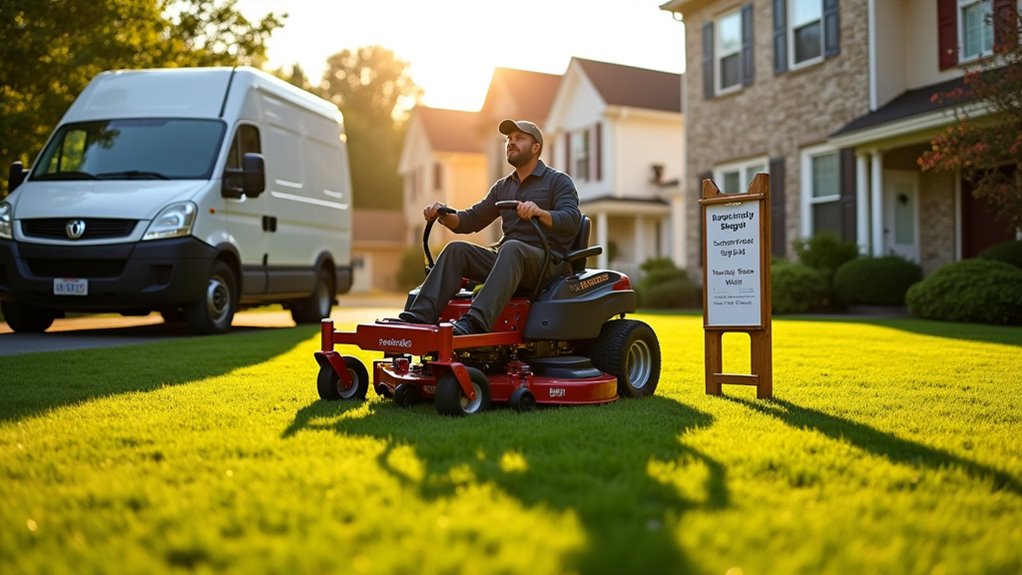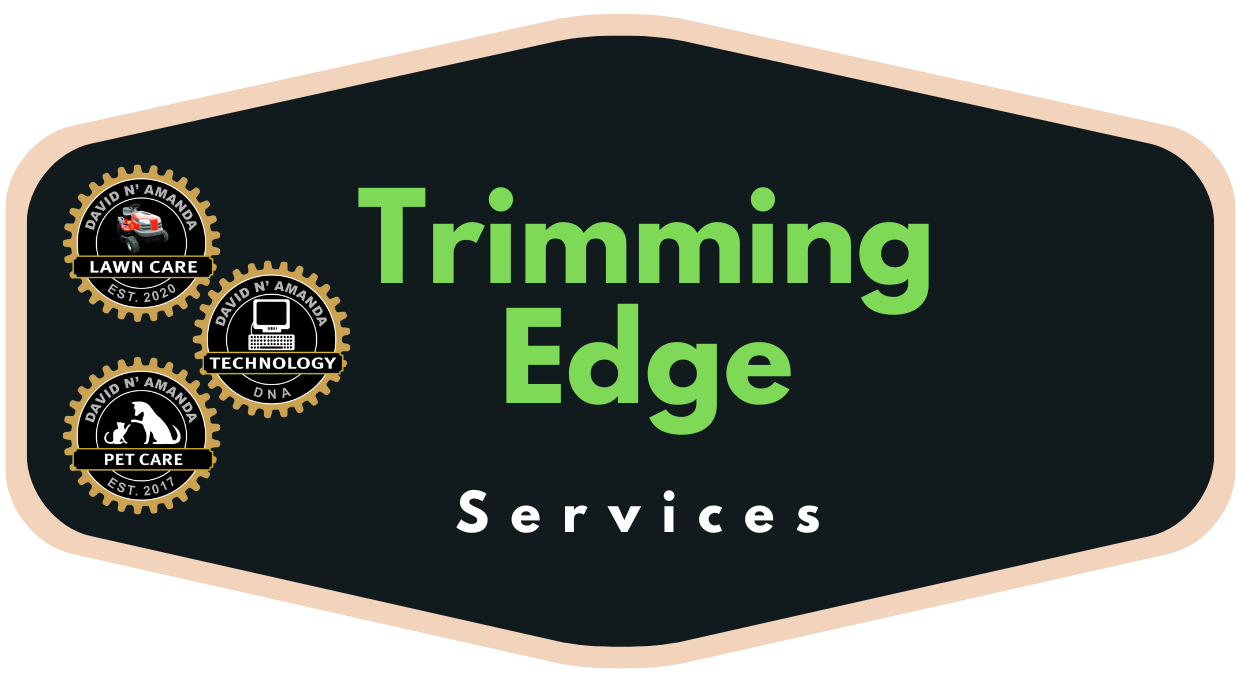Basic lawn mowing services cost you $30-65 per visit for lots under 8,000 square feet, with professional companies charging $50-65 and independent operators $30-45. You’ll pay 30-40% more in Northeast and West Coast regions, while Midwest and Southeast rates remain competitive at $35-50. Annual contracts can save you 15-20%, averaging $2,400-3,600 yearly. Premium packages with extensive features range from $150-275 per visit. Understanding pricing factors and regional variations will help optimize your lawn care investment.
Current Market Rates for Basic Lawn Mowing Services

Based on extensive market analysis across major U.S. metropolitan areas, basic lawn mowing services currently range from $30 to $65 per visit for standard residential lots under 8,000 square feet.
You’ll find that companies using professional-grade mowing equipment typically charge on the higher end, around $50-65, while independent operators often price their services between $30-45. Service reviews indicate that higher-priced providers generally deliver more consistent results and offer add-on services like edging and cleanup.
Pricing variables include lot accessibility, terrain type, and grass height. If your property has slopes steeper than 15 degrees or requires specialized equipment, you can expect a 20-30% surcharge. Weekly maintenance contracts often provide the best value, with companies offering 10-15% discounts for regular scheduling.
Factors Affecting Lawn Care Pricing in 2025
Your lawn care costs in 2025 will primarily depend on your property’s size and location, with urban areas commanding premium rates due to higher operational expenses. You’ll find that service type selection, whether basic mowing or extensive maintenance packages, directly impacts your total investment. The frequency of service visits you choose will affect your pricing tier, with weekly maintenance typically offering the most cost-effective rates per visit compared to bi-weekly or monthly options.
Property Size and Location
Two primary drivers will determine your lawn care costs in 2025: property dimensions and geographical location. Based on current lawn maintenance trends, you’ll find significant price variations between urban and suburban areas, with urban zones commanding premium rates due to higher operating costs.
| Location Type | Average Cost (per 1/4 acre) |
|---|---|
| Urban Core | $85-105 |
| Inner Suburb | $70-90 |
| Outer Suburb | $55-75 |
| Rural Area | $45-65 |
Your property’s specific dimensions will directly impact service costs. You’ll pay more for larger lots, but often at a decreasing rate per square foot. Most companies now use satellite imaging to precisely measure your property, ensuring accurate quotes. Factors like lot accessibility, terrain complexity, and regional economic conditions will further adjust your final pricing.
Service Type and Frequency
Service frequency and package selections create substantial price variations in the 2025 lawn care market. You’ll find basic weekly mowing services starting at $45 per visit, while extensive maintenance packages can exceed $200 weekly. Monthly service contracts typically offer 10-15% savings compared to per-visit rates.
Premium packages include fertilization, weed control, and seasonal cleanup, driving service quality and customer satisfaction metrics higher. You’re looking at $150-275 monthly for standard bi-weekly maintenance, while full-service weekly programs range from $300-600 monthly. Most companies now offer flexible scheduling through mobile apps, letting you adjust service frequency based on weather patterns and grass growth rates. Add-on services like aeration ($100-175) and overseeding ($200-300) remain popular seasonal options in 2025’s competitive market.
Regional Price Variations Across the United States

While lawn care prices fluctuate markedly across the United States, regional factors like cost of living, climate, and market competition drive these variations. You’ll find the highest rates in the Northeast and West Coast, where basic lawn maintenance can cost 30-40% above the national average. Cities like Boston, New York, and San Francisco typically charge $65-85 per visit for a standard quarter-acre lot.
The Midwest and Southeast offer more competitive rates, with service costs ranging from $35-50 per visit. Regional pricing in these areas remains lower due to extended growing seasons and higher service provider density. When making service comparisons, you’ll notice that Southern states often require more frequent visits due to longer growing seasons, while Northern regions concentrate services during shorter seasonal windows.
Premium Lawn Care Package Costs
Premium lawn care packages in 2025 will command considerably higher prices than basic maintenance services, typically ranging from $150-275 per visit. These extensive packages include premium features that improve your property’s overall health and aesthetic appeal.
You’ll find service customization options that align with your specific outdoor needs:
- Advanced soil treatments with organic amendments and specialized fertilizers ($75-100 supplement)
- Precision tree and shrub care including deep root fertilization and targeted pest management ($85-125 add-on)
- Seasonal color rotation with premium flower varieties and professional outdoor design consultation ($90-150 extra)
When selecting a premium package, you’re investing in specialized expertise and high-end materials. Most companies offer quarterly or annual contracts, providing cost savings of 15-20% compared to individual service bookings.
Seasonal Service Plans and Annual Contracts

You’ll save 15-20% on average by choosing annual lawn care contracts over month-to-month services in 2025, with top providers offering supplementary 5-10% early payment discounts for full prepayment. Most annual contracts include 25-30 scheduled visits, while monthly plans typically require separate agreements for each growing season at higher per-visit rates. Your commitment to longer service terms (12-24 months) opens premium benefits like priority scheduling, free service calls, and seasonal extras that aren’t available with short-term arrangements.
Monthly Vs Annual Pricing
Homeowners face a critical decision between monthly service payments and annual lawn care contracts when evaluating costs for 2025. When comparing pricing models, you’ll find that annual commitments typically offer 15-20% savings over monthly rates, but require larger upfront payments.
- Annual contracts average $2,400-3,600 for all-encompassing care, breaking down to $200-300 monthly when prepaid
- Monthly service plans range from $250-350 per month without commitment, totaling $3,000-4,200 yearly
- Seasonal payment options fall between these extremes, offering quarterly payments with moderate monthly savings
Your choice should factor in cash flow preferences and service consistency needs. While monthly payments provide flexibility, annual contracts lock in rates and guarantee priority scheduling during peak seasons. Consider your property’s specific requirements and budget constraints when selecting between these pricing structures.
Contract Length Benefits
Contract length decisions impact both service quality and financial outcomes in 2025’s lawn care market. When you commit to longer service agreements, you’ll typically secure 15-25% cost savings compared to month-to-month arrangements. Annual contracts now average $2,800, while seasonal plans range from $1,400 to $1,800.
Your contract flexibility options have expanded in 2025, with 68% of providers offering customizable service intervals. By choosing a 12-month commitment, you’ll lock in priority scheduling and rate protection against seasonal price fluctuations. Customer loyalty programs tied to longer contracts deliver supplementary value, including free service upgrades and priority response times. Data shows that homeowners with annual contracts report 30% higher satisfaction rates and receive consistent, well-timed maintenance throughout the year.
Early Payment Discounts
Smart budgeting in 2025’s lawn care market starts with early payment advantages. You’ll find significant savings when you utilize early payment incentives, with many companies offering customer loyalty rewards for upfront seasonal or annual commitments.
- Pre-pay your annual contract to receive 15-20% off standard service rates, translating to an average savings of $425 for all-inclusive lawn care packages
- Choose seasonal pre-payment options to access 10-12% discounts while maintaining quarterly payment flexibility
- Combine early payment with customer loyalty rewards to enhance savings up to 25% on premium services
Industry data shows that 72% of lawn care providers now offer structured discount programs for early payment commitments. By analyzing your service needs and available payment options, you’ll refine your lawn care budget while securing premium maintenance slots throughout the year.
Additional Services and Their Price Points
Professional lawn care providers typically offer an array of supplemental services beyond standard mowing and maintenance, with 2025 projections showing a 15-20% price increase from current rates. You’ll find organic treatments ranging from $85-150 per application, while traditional chemical treatments cost $65-120. Pest control services average $125-275 per treatment, depending on lot size and infestation severity.
Additional specialized services include aeration ($175-275), overseeding ($200-350), and tree/shrub care ($150-400 annually). Seasonal cleanup packages run $200-450, while hardscaping projects start at $1,500. For extensive lawn renovation, expect to pay $2,000-5,000, depending on square footage and soil conditions. These premium services often require specialized equipment and certified technicians, contributing to higher price points in urban markets.
Cost Comparison: Professional vs. DIY Lawn Maintenance
While the array of professional services offers convenience, comparing their costs against DIY approaches reveals significant financial implications for homeowners in 2025. Professional services average $2,800-$3,500 annually for standard maintenance, while DIY strategies can reduce expenses to $800-$1,200 per year.
- Equipment investment for DIY maintenance requires $1,500-$2,000 upfront, but these tools last 3-5 years with proper care
- Cost saving techniques like seasonal fertilization and proper mowing height management can reduce long-term expenses by 40%
- Time investment for DIY maintenance averages 4-6 hours weekly, valued at $25-35 per hour if comparing to professional rates
Your decision between professional and DIY maintenance should factor in both monetary costs and time investment, as equipment depreciation and maintenance impact total expenses.
Tips for Getting the Best Value From Lawn Care Companies
Five key strategies can improve your investment when hiring lawn care services in 2025’s competitive market. To begin, negotiate multi-season contracts to secure rates 15-20% below standard pricing. Second, bundle services like mowing, fertilization, and pest control for an average savings of $475 annually. Third, utilize customer loyalty programs, which typically offer 5-10% cashback or service credits after your initial year.
Fourth, schedule services during off-peak months (March and October) when companies often discount rates by 25-30%. At last, request detailed service breakdowns and compare them across three providers minimum. Companies offering transparent pricing structures typically deliver 22% better value than those with package-only options. Your careful analysis of these factors will optimize service quality while minimizing costs in today’s $98.5 billion lawn care industry.
Frequently Asked Questions
Are Lawn Care Companies Required to Be Licensed and Insured?
You’ll find that licensing requirements for lawn care companies vary by state and municipality. Most areas require a business license, and if you’re using pesticides, you’ll need specific chemical application permits. Insurance coverage is typically mandatory, including general liability insurance (protecting against property damage and injuries) and workers’ compensation if you have employees. It’s essential to check your local regulations, as operating without proper licensing and insurance can result in significant fines.
What Happens if Equipment Damages My Property During Lawn Service?
If a lawn service provider damages your property, you should immediately document the damage with photos and notify the company. Reputable companies carry liability coverage specifically for these incidents. You’ll need to file damage claims through their insurance provider, which typically covers repairs or replacement costs. That’s why it’s essential to only work with insured companies their coverage protects both you and their business from costly property damage expenses.
Can I Change or Cancel Scheduled Lawn Services Without Penalties?
Most lawn care companies offer service flexibility, but cancellation policies vary by provider. You’ll typically need to give 24-48 hours’ notice to modify or cancel a scheduled service without penalties. Many companies allow online scheduling changes through their customer portals. For long-term contracts, you might face early termination fees, usually 10-20% of the remaining contract value. It’s best to review your service agreement carefully and understand the specific cancellation terms before signing.
Do Lawn Care Companies Offer Emergency or Same-Day Service?
You’re in luck! Many lawn care companies do offer emergency services and same-day availability, though you’ll typically pay a premium of 25-40% above standard rates. While most providers require 24-48 hours’ notice, you can find companies that’ll respond to urgent situations like fallen trees, storm damage, or last-minute event preparation. It’s best to contact multiple services early in the day, as same-day slots fill quickly and may cost more during peak seasons.
How Early in the Morning Do Lawn Care Companies Start Work?
Most lawn care companies start their work hours between 7:00 AM and 8:00 AM, though you’ll find some begin as early as 6:00 AM during peak summer months. Your location’s noise ordinances typically regulate early morning start times. Professional crews prefer these early starts to optimize daylight hours and avoid afternoon heat. If you’re concerned about timing, you can request a specific time slot when scheduling, though early morning slots are often premium-priced.


No responses yet